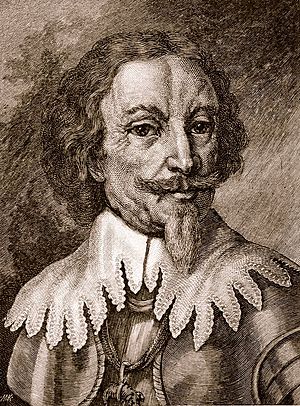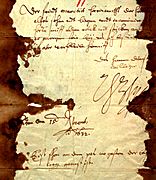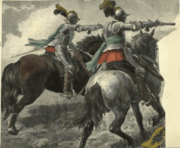Gottfried Heinrich Graf zu Pappenheim facts for kids
Quick facts for kids
Gottfried Heinrich Graf zu Pappenheim
|
|
|---|---|

Gottfried Heinrich Graf zu Pappenheim
|
|
| Born | 29 May 1594 Pappenheim on the Altmühl, Bavaria |
| Died | 17 November 1632 (aged 38) Leipzig, Saxony |
| Allegiance | |
| Years of service | 1618–1632 |
| Battles/wars | Thirty Years' War |
Gottfried Heinrich, also known as Count Pappenheim, was an important military leader during the Thirty Years' War. He was a field marshal for the Holy Roman Empire. Pappenheim strongly supported the Catholic League. He was badly hurt during the Battle of Lützen. In this battle, he fought against the Protestant armies led by the Swedish king Gustavus Adolphus. He died from his injuries.
Contents
Early Life and Military Start
Gottfried Heinrich was born on May 29, 1594. His family were the Lords of Pappenheim in Bavaria. He studied at universities like Altdorf and Tübingen. After his studies, he traveled around Europe. During his travels, he learned several languages. In 1614, he decided to become a Roman Catholic. This faith became very important to him.
When the Thirty Years' War began, Pappenheim joined the army. He first served in Poland. This experience was very helpful. He learned a lot about cavalry fighting. This knowledge later helped him in the Catholic League's army.
Rising Through the Ranks
Pappenheim quickly became a lieutenant-colonel. He showed great bravery in his first major battle. This was the Battle of the White Mountain near Prague in 1620. He was so badly injured that he was left for dead. But he survived!
The next year, he fought in western Germany. By 1622, he was a colonel. He led a group of cuirassiers, who were heavily armored cavalry soldiers. In 1623, Pappenheim helped Spain, an ally of the Holy Roman Empire. He raised troops for a war in Italy. He became famous for bravely defending Riva on Lake Garda.
Putting Down Rebellions
In 1626, Maximilian I of Bavaria called Pappenheim back to Germany. Maximilian was the leader of the Catholic League. He asked Pappenheim to stop a peasant rebellion in Upper Austria. Pappenheim quickly put down the rebellion. He faced strong resistance but was successful. The rebellion ended in just a few weeks.
After this, Pappenheim fought alongside Tilly. They fought against Christian IV of Denmark. Pappenheim helped capture the city of Wolfenbüttel. In 1628, he was given the title of Count of the Empire.
Key Battles and Campaigns
Pappenheim was involved in the siege of Magdeburg. This was a very harsh event where the city was captured. He also fought at the Battle of Breitenfeld. This battle was a big loss for the Imperial army. Pappenheim was known for his daring cavalry charges. After the defeat, he skillfully covered the army's retreat.
He then gained fame for his actions along the lower Rhine and Weser rivers. He kept the Swedish army busy. His small force stopped important reinforcements from reaching the Swedish king. Pappenheim was very active. He moved his troops across a wide area, from Stade to Kassel.
Final Battle and Death
Pappenheim became a field marshal in the Imperial army. He was called to join Wallenstein in Saxony. They were fighting the Swedes. But Pappenheim was sent away again towards Cologne. While he was gone, a major battle was about to happen. Pappenheim was urgently called back.
He arrived with his cavalry in the middle of the Battle of Lützen on November 16, 1632. His fierce attack was successful for a short time. Pappenheim was always looking for the toughest fight. He was looking for Gustavus Adolphus, the Swedish king. Around the same time the king was killed, Pappenheim was also badly wounded. He died later that day or early the next morning. He was on his way to Leipzig.
Legacy
- The type of sword called a Pappenheimer is named after him.
- In Poland, "pappenheimer" refers to a kind of helmet. This helmet was worn by heavy cavalry during the Thirty Years' War.
- In German, there is a saying: "I know my Pappenheimer" (Ich kenne meine Pappenheimer). This phrase means you know what to expect from certain people, often in a negative way. It comes from a play by Schiller.
Gallery
-
The Bauernhügel monument in Pinsdorf, Upper Austria, commemorates the peasant insurgents suppressed by Papenheim. It appears on the village's coat of arms
Sources
- Kriegsschriften von baierischen Officieren I. II. V. (Munich, 1820);
- Hess, Gottfried Heinrich Graf zu Pappenheim (Leipzig, 1855);
- Ersch and Grüber, Allgem. Encyklopädie, III. II (Leipzig, 1838);
- Wittich, in Allgem. deutsche Biographie, Band 25 (Leipzig, 1887), and works there quoted.
See also
 In Spanish: Gottfried von Pappenheim para niños
In Spanish: Gottfried von Pappenheim para niños





